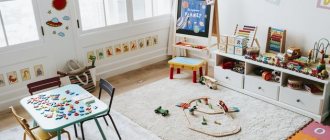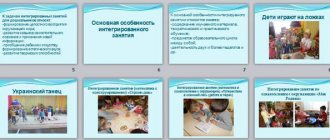“Use of technology of person-centered interaction in pedagogical practice”
Author: Polyakova Elena Anatolyevna
Municipal preschool educational budgetary institution "Kindergarten of a combined type No. 3
Lesozavodsky urban district"
Use of technology
personality-oriented interaction
in pedagogical practice
Author: Polyakova Elena Anatolyevna,
speech therapy group teacher,
highest qualification category
Lesozavodsk
2016
The Federal State Educational Standard for Preschool Education designates the following basic principles of preschool education: supporting the specificity and diversity of childhood; preserving the uniqueness and intrinsic value of childhood as an important stage in the overall development of a person; personal developmental and humanistic nature of interaction between adults and children; respect for the child’s personality is a mandatory requirement for all adult participants in educational activities.
Modern pedagogical technologies are designed to help teachers implement the basic principles of the Federal State Educational Standard for Education.
Pedagogical technology is an integral scientifically based project of a certain pedagogical system from its theoretical concept to implementation in educational practice. Technologies answer the question: how to teach, how to act so that the results coincide with the requirements?
Technologies of person-oriented interaction are health-saving pedagogical technologies. One of the classifications of these technologies is technology for ensuring the socio-psychological well-being of the child (ensuring the mental and social health of the child and aimed at ensuring the emotional comfort and positive psychological well-being of the child in the process of communicating with peers and adults in kindergarten and family). Let us dwell on the technology for ensuring the socio-psychological well-being of the child, which I use in my teaching practice at the MDOBU “D/S combined type No. 3 LGO”. Having become interested in this technology, I decided to apply it in my teaching activities for the development and correction of the emotional world of preschoolers.
The need to use this technology, create and develop a system of developmental and correctional activities for the development of the emotional sphere of older preschoolers was dictated by the fact that every year our preschool educational institution recruits a speech therapy group of children with speech underdevelopment who previously attended other groups. Therefore, every year the issue of adapting children, uniting the children's team, and establishing contact between the teacher and children who suffer not only from speech impediments, but are also characterized by increased conflict levels arises.
Formation process
social and personal qualities of a child at the present stage of development of the preschool education system, in the context of the implementation of the Federal State Educational Standard for Preschool Education, becomes particularly relevant. The development of the emotional-volitional sphere of the child is not only a prerequisite for successful schooling, but also contributes to the self-development of the individual. Therefore, work aimed at developing the emotional sphere is very relevant and important.
In this regard, one of the important areas of activity is to provide high-quality psychological and pedagogical support, which allows not only to overcome emerging difficulties in the educational process, but also to prevent them. Emotions play a significant role from the very beginning of a baby’s life, and serve as an indicator of his attitude towards his parents and what surrounds him. Currently, along with general health problems in children, experts note with concern the increase in emotional-volitional disorders, which result in more serious problems in the form of low social adaptation, a tendency to antisocial behavior, and learning difficulties.
The strongest and most important source of a child’s experiences is his relationships with other people, adults and children. The need to “be good” for others determines the child’s behavior. This need gives rise to complex multifaceted feelings: jealousy, sympathy, envy, etc. Despite all its apparent simplicity, recognizing and transmitting emotions is a rather complex process that requires a certain knowledge and a certain level of development from the child. Emotions do not develop on their own. The attitudes of the individual, her relationship to the world change, and emotions are transformed along with them. The main task is not to suppress and eradicate emotions, but to channel them appropriately.
Having become interested in this problem, I became acquainted with the works of outstanding scientists who studied the problem of emotional development of children: L.S. Vygotsky, A.N. Leontyeva, A.V. Zaporozhets and others and developed materials: methodological developments
• “Child-parent interactions in preschool children”,
where the reasons for the influence of child-parent interactions on the mental development of children are shown (a hot topic for discussion at the parent club);
• “Let’s help children cope with anxiety”
the work contains theoretical and practical parts, where specific games and exercises are selected, and recommendations are given for overcoming anxiety in children;
I have implemented projects:
· "My family"
(long-term, parent-child project). Working on it gave the children's team an opportunity to expand their understanding of family relationships and get to know the history of their family.
· "My inner world
"(short-term project), where project participants found a socially acceptable way out of conflict situations and drew up rules for getting out of them.
As part of the educational process, I carried out work on the correction and development of the emotional and volitional sphere of children according to the calendar and long-term planning of the educational field “Social and communicative development”.
The basis for calendar-long-term planning is the programs and teaching aids of the authors: S. I. Semenak “Lessons of Good”, I. A. Pazukhina “Let’s get to know each other!
Training development and correction of the emotional world of preschoolers”, E. A. Alyabyeva “Correctional and developmental classes for children of senior preschool age”, E. V. Barinova “Lessons of politeness and Kindness”, L. V. Kolomiychenko, G. I. Chugaeva, L. I. Yugova “Classes for children 6-7 years old” (social and communicative development), T. B. Mazepina “Development of a child’s communication skills in games, trainings, tests”, E. G. Churilova “Methodology and organization of theatrical activities preschoolers and primary schoolchildren” and others. The lesson system used games and exercises from the same authors.
The purpose of the training system is:
– increasing the child’s awareness of his emotional manifestations and relationships with other people to harmonize the development of his personality as a whole.
The objectives of the training system are:
— promote the development of the process of self-knowledge, increasing self-esteem;
— to develop in children the skills to understand their emotional states and the people around them through theatrical activities, replenishing the child’s active vocabulary with verbal symbols of emotions;
- learn to express your love for loved ones, cultivate interest in the history of your family;
- develop skills of adequate social behavior, understanding of belonging to a particular group;
- develop ways of effectively interacting with people, friendly relationships.
In accordance with the set objectives, classes were structured in a form that was accessible and interesting for children. The main methods and techniques used in the classes were: psycho-gymnastics, role-playing and developmental games (dramatization games, games to develop communication skills), exercises (imitative-performing and creative, for muscle relaxation), sketches, examination of drawings and photographs , reading and discussion of works of art, therapeutic fairy tales, viewing and analysis of fragments of cartoons, discussions, group work, playing out the emotional state, playing out conflict situations and teaching children how to get out of them, expressing their emotional state through drawing, theatrical skits, working with parents on prevention anxiety, etc.
Form of classes: correctional and developmental classes, trainings with children were conducted in a group form 1-2 times a week in the afternoon. The thematic lesson plan consists of 4 sections:
1.
Block "Me and I"
2.
Block “Me and my family”
3.
Communication block “I and others”
4.
Emotional block “Me and my emotions.”
This series of classes will be useful not only in speech therapy groups, but also in those groups where there are many children with deviant behavior. A system of classes on emotional development should be carried out from the middle group, if we take I.A. Pazukhina’s methodological manual as a basis. The same topic should be covered in different age groups, using games and exercises appropriate for a given age, the content of which is qualitatively expanded and deepened.
When creating a subject-spatial developmental environment in the group, I took into account the principle of the emotiogenicity of the environment, individual comfort and emotional well-being of each child, for this I organized a “MOOD CORNER”,
to teach children to understand their emotions and know how to manage them. In the emotional development zone there are a variety of printed board games for the development of the emotional sphere, anti-stress balls and the album “What to do when you are angry?” to help your child cope with anger. A tape recorder, disks with musical works, with cartoons on the topics of moral education, albums, crayons for drawing your mood, friends.
As a result of the work carried out on the correction and development of the emotional and volitional sphere, children began to distinguish and explain their emotional state and the emotional state of other people, the level of transmission of emotional states of speech improved, and the ability to correctly respond to various life situations from an emotional point of view developed.
Thus, personality-oriented technologies are characterized by a humanistic and psychotherapeutic orientation and are aimed at the versatile, free and creative development of the child as a subject of activity.
Attached files: comments powered by HyperComments



